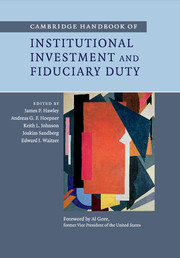Book contents
- Frontmatter
- Contents
- List of figures
- List of tables
- List of contributors
- Foreword
- 1 Introduction
- Part I Fiduciary duty: a global outlook
- Part II Fiduciary duty and the landscape of institutional investment
- 8 The philanthropic fiduciary: challenges for nonprofits, foundations and endowments
- 9 Paradigm lost: employment-based defined benefit plans and the current understanding of fiduciary duty
- 10 Economically targeted investing: changing of the guard
- 11 Institutional investment in the European Union Emissions Trading Scheme
- 12 Have institutional fiduciaries improved securities class actions? A review of the empirical literature on the PSLRA’s lead plaintiff provision
- 13 The future of fiduciary obligation for institutional investors
- Part III Challenging conventional wisdom on fiduciary duty
- Part IV Towards a broader interpretation of fiduciary duty
- Part V Beneficiaries’ roles and viewpoints
- Part VI Fiduciary duty and governance
- Index
- References
12 - Have institutional fiduciaries improved securities class actions? A review of the empirical literature on the PSLRA’s lead plaintiff provision
Published online by Cambridge University Press: 05 April 2014
- Frontmatter
- Contents
- List of figures
- List of tables
- List of contributors
- Foreword
- 1 Introduction
- Part I Fiduciary duty: a global outlook
- Part II Fiduciary duty and the landscape of institutional investment
- 8 The philanthropic fiduciary: challenges for nonprofits, foundations and endowments
- 9 Paradigm lost: employment-based defined benefit plans and the current understanding of fiduciary duty
- 10 Economically targeted investing: changing of the guard
- 11 Institutional investment in the European Union Emissions Trading Scheme
- 12 Have institutional fiduciaries improved securities class actions? A review of the empirical literature on the PSLRA’s lead plaintiff provision
- 13 The future of fiduciary obligation for institutional investors
- Part III Challenging conventional wisdom on fiduciary duty
- Part IV Towards a broader interpretation of fiduciary duty
- Part V Beneficiaries’ roles and viewpoints
- Part VI Fiduciary duty and governance
- Index
- References
Summary
Introduction
Congress passed the Private Securities Litigation Reform Act of 1995 (PSLRA) to address perceived problems in securities class action litigation. A key feature of the PSLRA was the lead plaintiff provision. Prior to passage of the statute, representative plaintiffs were invariably small shareholders, often with long-term relationships with class counsel (Perino 2008). As a result, these class members typically had insufficient incentives to monitor class counsel, creating the opportunity for attorneys to act in their own best interests rather than the best interests of the class. Inspired by the work of Weiss and Beckerman (1995), Congress created the lead plaintiff position in the hope that institutional investors would volunteer to serve as representative (now dubbed lead) plaintiffs. Weiss and Beckerman argued and Congress expected that because of their larger, often long-term, financial stakes and greater sophistication, institutions would provide the monitoring necessary to curb the agency costs that had been endemic to securities class actions.
Whether institutions would take up this invitation, however, was an open question. While collective action problems make institutional passivity the norm, investment managers are fiduciaries and as such have a duty to keep “informed of rights and opportunities associated with [their] investments” and to initiate and participate in litigation on behalf of the trust under certain circumstances. Under basic common law principles, the decision to pursue litigation is contingent, in part, on whether the expected gain from litigation will exceed the expected cost. The Employee Retirement Income Security Act (ERISA) imposes a similar duty of care on ERISA trustees, although some commentators have argued that serving as lead plaintiff could itself violate those duties (Martin and Metcalf 2001). To further complicate matters, the decision not to pursue the lead plaintiff position could implicate duty of loyalty issues to the extent that the decision is premised on the investment managers’ interests as opposed to those of the beneficiaries.
- Type
- Chapter
- Information
- Publisher: Cambridge University PressPrint publication year: 2014
References
- 2
- Cited by



